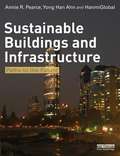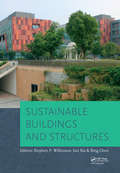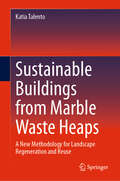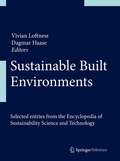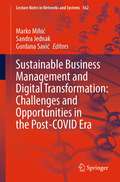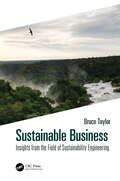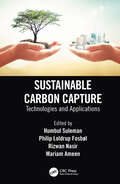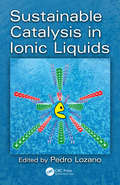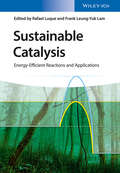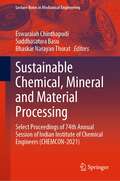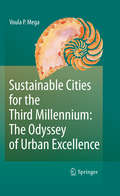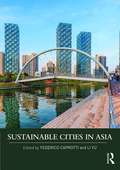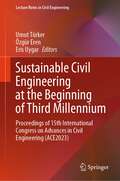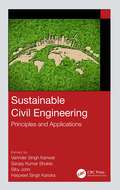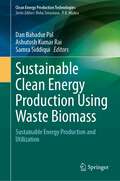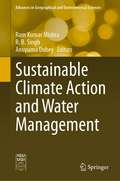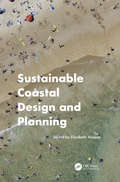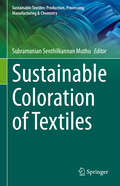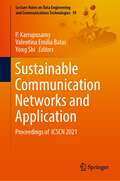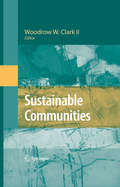- Table View
- List View
Sustainable Buildings and Infrastructure: Paths to the Future
by Annie Pearce Ltd Hanmiglobal Co Yong Han AhnConstruction is one of the biggest industries in the world, providing necessary facilities for human prosperity ranging from the homes in which we live to the highways we drive, the power plants that provide energy for our daily activities, and the very infrastructure on which human society is built. The construction sector, including the building sector, has among the largest potential of any industry to contribute to the reduction of greenhouse gas emissions. This ambitious and comprehensive textbook covers the concept of embedding sustainability across all construction activities. It is aimed at students taking courses in construction management and the built environment. Written in a lively and engaging style the book sets out the practical requirements of making the transition to a sustainable construction industry by 2020. Case studies are included throughout making the book both a core reference and a practical guide.
Sustainable Buildings and Structures: Proceedings of the 1st International Conference on Sustainable Buildings and Structures (Suzhou, P.R. China, 29 October - 1 November 2015)
by Bing Chen Jun Xia Stephen P. WilkinsonSustainable Buildings and Structures collects the contributions presented at the 1st International Conference on Sustainable Buildings and Structures (Suzhou, China, 29 October-1 November 2016). The book aims to share thoughts and ideas on sustainable approaches to urban planning, engineering design and construction. The topics discussed include:-
Sustainable Buildings from Marble Waste Heaps: A New Methodology for Landscape Regeneration and Reuse
by Katia TalentoThis book examines how discarded marble heaps can be repurposed, in situ, to breathe new life into the landscape, offering solutions that are as innovative as they are practical and sustainable. The author showcases the power of creativity and sustainability to revitalize communities and landscapes with new architectural buildings and public spaces. The volume combines theory with practice, including an extensive bibliography about landscape mutation, rehabilitation of quarries and waste reuse, and, at the same time, a detailed case study on the Estremoz Anticline, in Portugal, one of the world’s main sites of marble extraction. Of all the material extracted from the several quarries of the Estremoz Anticline, only about 9% is marketed because of assessed of quality standards. Distinct from other research volumes in this domain, “Sustainable Buildings from Marble Waste Heaps” focuses on the regeneration of industrial landscapes through the on-site reuse of waste heaps, without removing the material from the context it belongs to or changing its morphology, preserving the identity of the place and promoting circular economy.
Sustainable Built Environment: Select Proceedings of ICSBE 2023 (Lecture Notes in Civil Engineering #451)
by Thayaparan Gajendran Deepak Bajaj Sanjay PatilThis book presents the select proceedings of International Conference on Sustainable Built Environment (ICSBE 2023). It discusses the issues of sustainability and resilience in all types of building projects, construction projects, operational building, and infrastructure projects within urban regions of the world. The key themes covered in this book are sustainable urban planning, sustainable construction, real estate, housing, net-zero built environment, climate change policy, legal framework, climate finance, technology, and innovation toward decarbonization of the built environment. This book is useful for researchers and professionals working in the fields of construction management, built environment, and allied fields.
Sustainable Built Environments
by Vivian Loftness Dagmar HaaseSustainable design is a collective process whereby the built environment achieves unprecedented levels of ecological balance through new and retrofit construction, with the goal of long-term viability and humanization of architecture. Focusing on the environmental context, sustainable design merges the natural, minimum resource conditioning solutions of the past (daylight, solar heat, and natural ventilation) with the innovative technologies of the present. The desired result is an integrated "intelligent" system that supports individual control with expert negotiation for resource consciousness. International experts in the field address the fundamental questions of sustainable design and landscape management: How should the sustainability of landscapes and buildings be evaluated? Which targets have to be set and which thresholds should not be exceeded? What forms of planning and governance structures exist and to what extent do they further the goals of sustainability? Gathering 30 peer-reviewed entries from the Encyclopedia of Sustainability Science and Technology, Sustainable Built Environments provides comprehensive, multidisciplinary coverage of these issues and other aspects of sustainable building and landscape design.
Sustainable Business Management and Digital Transformation: Challenges and Opportunities in the Post-COVID Era (Lecture Notes in Networks and Systems #562)
by Marko Mihić Sandra Jednak Gordana SavićThis book covers high-quality peer-reviewed research papers presented at the 18th International Symposium of Organizational Sciences (SymOrg 2022) held in Belgrade, Serbia, from 11 to 14 June 2022. The aim of the book is providing stimulative framework for readers to explore viable alternatives and indicate implications for the post-pandemic world. Researchers from academia and industry present their original work focusing on different aspects of sustainable management and digital transformation including blockchain technology, business analytics, e-business, innovation, digital operations and logistics management, financial industry, public administration, lean business systems, digital transformation projects, human resources, marketing and communication, and quality and standardization. The chapters could be useful for industry experts, research institutions, universities, and all others who share a common interest in contemporary organizational sciences.
Sustainable Business: Insights from the Field of Sustainability Engineering
by Bruce TaylorEngineers have applied science to land people on the moon, design the cars we drive, and cram the power of a 20th-century supercomputer into the phones we carry. But what can happen when engineering’s systemic problem-solving skills are applied to improving the sustainability of business?This book stands on the shoulders of sustainability engineering insights to supplement business, engineering, and environmental curricula with tools necessary to effectively and efficiently improve the sustainability of organizations. Cutting through the clutter of terminology and approaches, this book uses case studies to outline a proven path to profitably secure “net zero” for facilities and their supply chains. And rather than stopping at the uninspiring target of “doing no harm,” it further empowers businesses and other organizations to create additional economic, environmental, and social benefits.This book: Offers numerous case studies from the Space Shuttle through the world’s first carbon neutral major food company to appropriate technology for safe water in developing countries to illustrate how to reduce environmental footprints while increasing profit margin and business value Explores redemptive entrepreneurship through the lens of the author’s founding of an award-winning engineering firm Presents strategies to strengthen the curricula of engineering, business, accounting, and procurement programs by uncovering significant sources of untapped value in conventional teaching
Sustainable Cacao Cultivation in Latin America (Earthscan Food and Agriculture)
by Naga Raju Maddela Luz Cecilia García Freddy Zambrano Gavilanes Carolina Aguilar DuarteThis book examines cacao cultivation with a view to improving the sustainable management and production of this crop.Theobroma cacao is an important species originating in the Ecuadorian Amazon and its product chocolate is consumed worldwide. Cacao cultivation is an industry supporting over ten million people, and so it is vitally important, in this changing climate, that the species is properly and sustainably managed and cultivated. This book brings together a wide range of experts from across the globe to examine cacao cultivation, from the basic aspects of reproduction, genetic improvement, nutrition and pest management, to agroforestry, industrialization and marketing in a global food system. Case studies are drawn from across Latin America, but the research reflects the nature of a crop that is cultivated in over 60 countries and processed, manufactured and consumed worldwide.This book will be of great interest to students and scholars of agronomy, sustainable agriculture, and crop science.
Sustainable Carbon Capture: Technologies and Applications
by Humbul Suleman Philip Loldrup Fosbøl Rizwan Nasir Mariam AmeenA comprehensive resource on different aspects of sustainable carbon capture technologies including recent process developments, environmentally friendly methods, and roadmaps for implementations. It discusses also the socio-economic and policy aspects of carbon capture and the challenges, opportunities, and incentives for change with a focus on industry, policy, and governmental sector. Through applications in various fields of environmental health, and four selected case studies from four different practical regimes of carbon capture, the book provides guidelines for sustainable and responsible carbon capture and addresses current and future global energy, environment, and climate concerns.
Sustainable Catalysis in Ionic Liquids
by Pedro LozanoSustainable Catalysis in Ionic Liquids provides an up-to-date overview of the relatively underexplored area of the use of room temperature ionic liquids as organocatalysts for a range of organic reactions, including polymerizations. Using organic molecules to promote reactions is an attractive option as these organic molecules can be safer than metal-based options. However, it is still important to be able to recycle and reuse these organic promoters. Ionic liquids provide this opportunity.
Sustainable Catalysis: Energy-Efficient Reactions and Applications
by Rafael Luque Frank Leung-Yuk LamHighlighting sustainable catalytic processes in synthetic organic chemistry, this useful guide places special emphasis on catalytic reactions carried out at room temperature. It describes the fundamentals, summarizes key advances, and covers applications in the field of organic synthesis, biomass conversion, and pollution control. Throughout, the latest research from various disciplines is combined, such as homogeneous and heterogeneous catalysis, biocatalysis, and photocatalysis. The book concludes with a chapter on future trends and energy challenges for the latter half of the 21st century and two case studies. With its multidisciplinary approach this is an essential reference for academic and industrial researchers in catalysis science aiming to design more sustainable and energy-efficient processes.
Sustainable Chemical, Mineral and Material Processing: Select proceedings of 74th Annual Session of Indian Institute of Chemical Engineers (CHEMCON-2021) (Lecture Notes in Mechanical Engineering)
by Suddhasatwa Basu Eswaraiah Chinthapudi Bhaskar Narayan ThoratThis book presents select proceedings of the Indian Chemical Engineering Congress (CHEMCON-2021) under the theme "Sustainable Utilization of Resources for Chemical Mineral Sectors". It covers broad topics such as chemical reaction and processes, material science and engineering, coal and mineral processing, pyro- and hydro-metallurgical processes, environmental engineering and waste management, advanced engineering, and energy materials. This book is useful for the researchers, professionals, and policymakers interested in sustainable utilization of chemical and mineral resources.
Sustainable Cities for the Third Millennium: The Odyssey of Urban Excellence
by Voula P. MegaThis book offers a 360 degree view of the challenges facing cities at the dawn of the millennium in terms of growth, governance, institutions and infrastructures, environmental well-being, social integration, science, culture and the arts, urban renaissance and planning, local democracy and citizenship. One year afte the crisis that started in 2008, the book presents responses to overcome the crisis of values and engage in a sustainability path from European and world cities.
Sustainable Cities in Asia
by Li Yu Federico CaprottiWith Asia’s cities undergoing unprecedented growth in the 21st century, lauded the ‘urban century’ by many, Sustainable Cities in Asia provides a timely examination of the challenges facing cities across the continent including some of the projects, approaches and solutions that are currently being tested. This book uses numerous case studies, analysing topical issues ranging from city cycling in India, to green spaces in China, to the use of community-led energy generation projects in post-Fukushima Japan. Containing contributions from an international team of scholars, it also takes a multi-disciplinary approach and draws on examples from a wide range of countries, including China, India, Japan, Korea, Taiwan, Singapore and the United Arab Emirates. Ultimately, by providing a comprehensive discussion of the broader debates around the shape of sustainable urbanism, it demonstrates that Asia is one of the most active regions in terms of the development of sustainable city strategies. Tackling the contemporary issues of key importance for sustainability, such as property markets, migration and transport, this book will appeal to students and scholars of Urban Geography, Sustainability, Environmental Studies and Asian studies.
Sustainable Civil Engineering Practices: Select Proceedings of ICSCEP 2019 (Lecture Notes in Civil Engineering #72)
by Sanjay Kumar Shukla Varinder S. KanwarThis book comprises select proceedings of the International Conference on Sustainable Civil Engineering Practices (ICSCEP 2019). It covers several important aspects of sustainable civil engineering practices dealing with effective waste and material management, natural resources, industrial products, energy, food, transportation and shelter, while conserving and protecting the environmental quality and the natural resource base essential for future development. The book also discusses engineering solutions to sustainable development and green design issues. Special emphasis is given on qualitative guidelines for generation, treatment, handling, transport, disposal and recycling of wastes. The book is intended as a practice-oriented reference guide for researchers and practitioners, and will be useful for all working in sustainable civil engineering related fields.
Sustainable Civil Engineering at the Beginning of Third Millennium: Proceedings of 15th International Congress on Advances in Civil Engineering (ACE2023) (Lecture Notes in Civil Engineering #481)
by Umut Türker Eris Uygar Özgür ErenThis volume comprises selected peer-reviewed proceedings of 15th International Congress on Advances in Civil Engineering (ACE 2023) was held in Famagusta, North Cyprus in September 2023. This proceedings covers all disciplines of Civil Engineering classified under six main topics: Construction Management, Hydraulics, Geotechnics, Materials, Structures, Transportation, and Civil Engineering Education. It covers highly diverse research topics including investigation in the areas of innovative materials in concrete production, recycling of waste in the construction industry, fibre reinforced and high strength concrete, soil stabilization, problematic soils of semi-arid and arid regions, deep foundations, staged construction modelling, repair and maintenance of reinforced concrete, earthquake engineering and seismic retrofitting, coastal and harbour engineering, water resources management, hydrology & hydraulics engineering, traffic engineering and urban transport, life cycle cost analysis, decision making strategies.
Sustainable Civil Engineering: Principles and Applications
by Varinder Singh KanwarThis reference text establishes linkages between the user industries and the providers of clean technologies and sustainable materials for a rapid transformation of the small and medium-sized enterprises (SMEs). The text covers several aspects of sustainable applications including clean technologies, climate change and its effects, sustainable buildings (smart cities), sustainability in road construction, sustainable use of geosynthetic, innovative materials, and sustainable construction practices. The text will be useful for senior undergraduate students, graduate students, and researchers in the fields of civil engineering and other infrastructure-related professionals and planners. The book: Discusses clean technologies and sustainable materials in depth Covers concepts of sustainability in road construction, and water retaining structures Examines environmental policies and practices Discusses climate change and its effects in a comprehensive manner Covers sustainable buildings including smart cities As this book discusses concepts related to sustainable civil engineering practices in a single volume, it will be an ideal reference text for everyone aiming at developments of sustainable infrastructures.
Sustainable Clean Energy Production Using Waste Biomass: Sustainable Energy Production and Utilization (Clean Energy Production Technologies)
by Dan Bahadur Pal Ashutosh Kumar Rai Samra SiddiquiThis edited volume covers sustainable biomass valorization and its application in various sectors.Bioenergy has concerned enormous attention as a promising alternative to conventional energy resources. Abundance of bioresources and their renewable nature provides a distinct advantage to biofuels from sustainability perspective. Biofuels have found increasing applications in the energy and transportation sector in recent years. Blended fuels are being used worldwide. However, several challenges remain to be addressed due to the diverse nature of biomasses and inherent recalcitrant nature of biological materials used as feedstock. This book aims to provide an overview of recent developments in the production of bioenergy and its applications in various areas. Specific emphasis is given to production of biofuels from modern biomass such as agro-forest waste and dedicated non-edible energy crops that do not interfere with food production. The scope of the book covers synthesis and characterization of biologically derived fuels, advances in microbiological methods and enzyme engineering approaches. The book covers techno-economic analysis to identify challenges and prospects for commercialization of biofuels. The directions for future research should pave way for net zero scenario for a sustainable world.The book will cater to a wide range of readers interested in learning the fundamentals as well as advances in the field of biofuels.
Sustainable Climate Action and Water Management (Advances in Geographical and Environmental Sciences)
by Ram Kumar Mishra R. B. Singh Anupama DubeyThis book discusses various issues relating to water resources, climate change and sustainable development. Water is the main driving force behind three major pillars of sustainable development: environmental, social and economic. As stated in the United Nations Sustainable Development Goals, development of these pillars rests on the availability and management of resources to fulfill the demand for water. By identifying the various challenges in the context of water resources and climate change, the book offers insights into achieving a better and more sustainable future. It provides a unique forum for practitioners and academics to exchange ideas on emerging issues, approaches, and practices in the area of water resources, climate change, and sustainability, while also presenting valuable information for policymakers on the changing contours of water management and climate change mitigation. As such it is a useful resource for decision-makers at the local as well as the global level.
Sustainable Coastal Design and Planning
by Elizabeth MossopAs different parts of the globe deal with the challenges of coastal settlements in the Anthropcene landscape of increasing uncertainty, the methods of design offer new strategies for developing and testing solutions. These complex problems require collaboration across disciplines, with scientists, planners, engineers, designers, and others able to work together in finding new ways of living in coastal and changing landscapes. Sustainable Coastal Design and Planning is an outstanding collection of essays by leading practitioners and academics from across the globe on design and planning for coastal resilience in the face of climate change. It thoroughly explores the questions of coastal change at different scales and provides international case studies that illustrate diverse strategies in different geographies and cultures. Taken as a whole, they canvas a broad palette of approaches and techniques for engaging these complex problems. Divided in two parts, this book focuses on how to develop solutions through multidisciplinary design thinking and informs all stakeholders on specific methods and practices that will be needed to work effectively in this dynamic space.
Sustainable Coloration of Textiles (Sustainable Textiles: Production, Processing, Manufacturing & Chemistry)
by Subramanian Senthilkannan MuthuThis volume provides a variety of cases on sustainable coloration of textiles. It offers valuable insights and solutions to reduce the environmental impact of textile dyeing and pollution due to extensive use of water, energy, and toxic chemicals. The cases presented in this book offer sustainable innovations and strategies to mitigate the impacts of textile coloration. This work will serve as an essential resource for students, educators, and practitioners looking to understand and implement sustainable practices in textile production.
Sustainable Communication Networks and Application: ICSCN 2019 (Lecture Notes on Data Engineering and Communications Technologies #39)
by Yong Shi P. Karrupusamy Joy ChenThis book presents state-of-the-art theories and technologies and discusses developments in the two major fields: engineering and sustainable computing. In this modern era of information and communication technologies [ICT], there is a growing need for new sustainable and energy-efficient communication and networking technologies. The book highlights significant current and potential international research relating to theoretical and practical methods toward developing sustainable communication and networking technologies. In particular, it focuses on emerging technologies such as wireless communications, mobile networks, Internet of things [IoT], sustainability, and edge network models. The contributions cover a number of key research issues in software-defined networks, blockchain technologies, big data, edge/fog computing, computer vision, sentiment analysis, cryptography, energy-efficient systems, and cognitive platforms.
Sustainable Communication Networks and Application: Proceedings of ICSCN 2021 (Lecture Notes on Data Engineering and Communications Technologies #93)
by Yong Shi Valentina Emilia Balas P. KarrupusamyThis book includes high-quality research papers presented at 3rd International Conference on Sustainable Communication Networks and Applications (ICSCN 2021), which is held at Surya Engineering College (SEC), Erode, India, during 29–30 July 2021. This book includes novel and state-of-the-art research discussions that articulate and report all research aspects, including theoretical and experimental prototypes and applications that incorporate sustainability into emerging applications. The book discusses and articulates emerging challenges in significantly reducing the energy consumption of communication systems and also explains development of a sustainable and energy-efficient mobile and wireless communication network. It includes best selected high-quality conference papers in different fields such as Internet of Things, cloud computing, data mining, artificial intelligence, machine learning, autonomous systems, deep learning, neural networks, renewable energy sources, sustainable wireless communication networks, QoS, network sustainability, and many other related areas.
Sustainable Communication Networks and Application: Proceedings of ICSCN 2020 (Lecture Notes on Data Engineering and Communications Technologies #55)
by Fuqian Shi Isidoros Perikos P. Karuppusamy Tu N. NguyenThis book includes novel and state-of-the-art research discussions that articulate and report all research aspects, including theoretical and experimental prototypes and applications that incorporate sustainability into emerging applications. In recent years, sustainability and information and communication technologies (ICT) are highly intertwined, where sustainability resources and its management has attracted various researchers, stakeholders, and industrialists. The energy-efficient communication technologies have revolutionized the various smart applications like smart cities, healthcare, entertainment, and business. The book discusses and articulates emerging challenges in significantly reducing the energy consumption of communication systems and also explains development of a sustainable and energy-efficient mobile and wireless communication network. It includes best selected high-quality conference papers in different fields such as internet of things, cloud computing, data mining, artificial intelligence, machine learning, autonomous systems, deep learning, neural networks, renewable energy sources, sustainable wireless communication networks, QoS, network sustainability, and many other related areas.
Sustainable Communities
by Woodrow W. Clark IIThe book starts with a discussion of global warming and climate change. The problem is well documented. Part One gives background for sustainable developments and gives studies of proven, substantiated and documented solutions. The time to act has begun. The "Green Revolution" has begun. Some authors call it The Third Industrial Revolution (Rifkin, 2005) since in the 21st century the industrially developed world has begun to move rapidly from fossil fuels (The Second Industrial Revolution) to renewable energy generation, storage technologies, and sustainable communities. Now is the time to understand and learn the tools that make sustainable communities of all kinds real. The book provides a vast, but not the total, amount of materials and data. The intent is to give students of sustainable development some well-established resources and tools. By 2008, the concept of "Green" had been so much in marketing and product services that it lost its meaning. The "branding" of green meant a whole new industrial sector suddenly emerged globally. However, the proof that there is both a Green Revolution and actual solutions to global warming must be seen in those sustainable communities who have existed, grown or developed using tested tools for sustainability. One of the key tools is the concern for conservation of natural resources, energy efficiency and the use of renewable energy systems (solar, wind, geothermal and bio-mass among others) along with storage devices for power generation. Communities in Europe and Asia have lead the way historically. The book presents actual cases of sustainable communities. The case of Frederikshavn in Denmark (Chapter # 6) clearly illustrates how small towns and villages can be sustainable. Far more intuitive and with common sense, Dos Lagos in California (Chapter #4) demonstrates how concern for the natural environment can create a mix-use community of homes, shops, offices and a golf course. Far more planned and strategic are the nine college campuses of the Los Angeles Community College District (Chapter #3) who recognized that public policy and that sector must lead the private sector by example as well as by proving the tools and economics of sustainable communities. And the private sector took note. A number of private companies from Safeway with its 20+ energy independent storage facilities to Toyota with Platinum LEED (Leadership in Environment and Energy Design) USA Headquarters in Torrance, California. Honda was not far behind with its "Green Hydrogen" Refueling station that electronizes solar energy into hydrogen for its hydrogen fuel cell cars. The Green Revolution could be seen with the hybrid cars that lead Toyota to be the No #1 Auto maker. Part Two of the book reviews the tools needed to make sustainable communities anywhere in the world. The key one is the technology (s) from science and engineering (Chapter #8). All too often people do not know that there are environmentally sound technologies that exist today (Clark, 2000) to make communities sustainable. Then when the political leaders discover that the technologies exist they argue that the costs are too high. Not true. And certainly not true today as Chapter #9 clearly demonstrates. There is the need to rethink basic cost benefit analyses for goods and services as being in the short term (2-3 years) into life cycle analyses (1-20 years) along with triple bottom line benefits and externality economic impacts on health, pollution and the atmosphere. In the end sustainable communities must be just that: capable of producing and using their own resources. Global warming starts and can end locally. If they need resources from outside or a long distance away, then those needs must be environmentally sound in terms of the goods themselves. And especially they must be sustainable in terms of transportation and services. This local and global change means new paradigms and approaches in public policy, environmentally sound technologies, economics and systems must be implemented today. Such a sustainable ...
